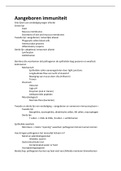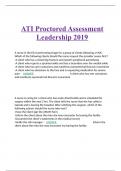(3de bachelor criminologie KUL)
1
Samenvatting Victimology and the criminal justice system (C02A0A), prof. Antony Pemberton
,Victimology and the criminal justice
system
1. Introduction (03/10)
Voor dit vak geen cijfers, wetten, .. kennen!!!
Examples:
- Sexual abuse, needle spiking, victims of terrorism, domestic violence …
- Leuven Restorative City (1 of 8 in Europe)
- Cambodja ’70 genocide: 2 million people died
- Ecocide: a new crime for the international court, animals as a victim (Polly Higgins)
- Movie ‘Unbelievable’: girl gets raped and no one believes her
Book ‘Aftermath’ by Susan Brison:
- Part one:
o Written by a victim of sexual abuse and attempted murder
o Illustrates some of the main themes of this course
o The pain doesn’t end when the attack ends, + new forms of suffering
o People think that sexual abuse before the attempted murder “makes sense”, they aren’t
surprised
o Victim feels ashamed, afraid, angry, guilty, derealisation, PTSD
- Part two:
o Sometimes feels like society “doesn’t care”
o ‘Just world theory’: people say they look less like a person if that person has experienced some
form of abuse recently (even if the pictures are same)
o Idea that you must have done something to deserve it, karma
o How do we know that only one in ten rapes are reported? => self-report surveys, victimization
surveys, …:
The International Crime Victim Survey (ICVS): door Jan van Dijk
Mostly used
o Typical crime stories:
Sherlock Holmes, Jeffrey Dahmer, …
Focus on detectives or perpetrator, not on the victims
Romanticising
- Part three:
o People don’t believe you or say you asked for it
o People make assumptions: “she was married so she was less likely to provoke the man”
Since when does victimology exist?
- 1984 (victims rights movement also started to come up)
- Hans von Hentig: German professor, ‘founder of victimology’:
o ’The criminal and his victim’
o Victim precipitation: what did the victim do? Who is he/she? Role of the victim in the event of the
crime
o +: how can victims potentially protect themselves (crime prevention)?
o -: should we blame the victim for his/her conduct?
Stereotypes:
- Picture grandson and grandma:
o Grandma most likely to look like the victim
o Grandson has the biggest risk of victimization
- Picture Madonna en 50 cents:
2
Samenvatting Victimology and the criminal justice system (C02A0A), prof. Antony Pemberton
, o Are both victims of crimes
o We don’t associate victims with succes and being famous
2. Criminological perspectives: part one (10/10)
2.1. What counts as victimization by crime?
Section 1: key idea:
- Complexity of counting prevalence/incidence of victimization of crime
- Going to be discussing a number of issues that can influence the way we understand what being a
victim can be like
Why is it complex? (Homicide (1) – stealing a bike (2) – creating drugs (3)):
o Who is a victim?
1. Friends and family, society, ..
2. The owner of the bike
3. Ex. the drug users, but very hard to count the number of victims because people won’t tell the
police they used
= Hard to determine who gets affected
- Other examples:
o Illegal downloading: the orginal artist, the music company
o Phishing: affects a lot of people, but hard to count because some people don’t know they’ve been
a victim, or they don’t say it to the police
Who is a criminal?
- Nelson mandela and Edward Snowden both broke the laws of their country, but can they also be
victims?
- Criminalization of prostitution: can people be victims of behaviour they (appear to) choose to
perform?
- Natasha Kampusch: was held captive in a basement for 8 years => victim?
- Anders Breivik: killed socialist people => not a victim?
Natasha does not want to be called a victim
Anders thinks he should be called a victim, he did something to protect himself and the country
Different perspectives on crime:
- Legalistic position
- Differences between countries and cultures, throughout history
- Crime as a social construction (Becker), as a social construct (Vold), who defines crime?
Or is there a more consensus view?
o Crimes reflect the values, beliefs and opinions of society
o Law is linked to social morality
2.2. What are the crime data sources?
Most dangerous countries in the world (based on homicide rates):
- Mexico
- Venezuela
- Brasil
- Honduras
- South Africa
3
Samenvatting Victimology and the criminal justice system (C02A0A), prof. Antony Pemberton
, !! But a lot of African countries don’t have data (Syria, South Sudan, Yemen …) while they probably
have the highest number of fatalities
Reason: war, hard to keep up with statistics while there’s a civil war going on for years
Homicide rates in Europe:
- Relatively higher in Eastern Europe
- Hightest in Russia
Complexity of interpreting crime numbers:
- Different ways of measuring between countries, through the years, …
- Ex. Police recorded number of crimes in Belgium (2000-2012) vs Reported crime in the Netherlands
(2005-2012): crime rate in Belgium increases while it decreases in the Netherlands (=> you need to
look at other trends in these countries to find the cause)
OFFICIAL STATISTICS
Reported crime in Europe 2014-2016:
- Lowest: Azerbaijan
- Highest: Iceland, 100x rate of Azerbaijan (<-> had the lowest homicide rate)
!! Dark number !!
Not all crimes are reported or detected by police, not all reported crimes are recorded, many crimes
rely on victim reports, differences and changes in definitions of crime, can be manipulated, …
Police data (dark) vs victim surveys (light):
Trends in violent crime vs victimization in the NL (2002):
More easy to report crimes because
of the internet, laptops, …
Conclusions?
- Crime drop vs crime rise (BE vs NL) => differences in how crimes are being reported
- Always look critically at numbers and statistics
VICTIM SURVEYS
ICVS:
- Large scale international survey
- By o.a. Prof. Jan van Dijk
4
Samenvatting Victimology and the criminal justice system (C02A0A), prof. Antony Pemberton
, - 6 waves in a period of 20 years
- Computer Assisted Telephone Interviewing (CATI), and face-to-face
- International comparative data
Why would victims not report their crimes?
- Victim is unaware that a crime has been perpetrated
- Shame, guilt
- They comitted a crime themselves
- They are scared for the responses
- They are threatened to prevent revelation
- They don’t want the offender to get punished
- They have no gain from reporting the offence
Crimes with the highest reported rate:
- Car theft
- Burglary
- Robbery
The victims want their belongings back
Sexual assault etc. have way lower rates
Reverse (crime in police registration while victim didn’t report it) vs forward (no registration while
victim has reported it) checks
Problems with victim surveys:
- Countries with more gender equality get higher rates of female victims of gender related violence
- Mentality: people in gender equal countries would likely be more open about these incidents
1. Not knowing:
o In patriarchic countries, the victims maybe don’t realise they are a victim of assault
2. Forgetting/not mentioning
o Conscious
o Unconscious
3. Inaccurate information:
o Forward telescoping: moving experience forward in time to fall the period of the survey
o Something that happened in 2018 for instance
o Mentioning other people’s experiences
4. Differences in “productivity”:
o Filling out a survey/answering questions is more difficult for people with a lower education
5. Increasing difficulty of achieving a representative sample:
o Reaching respondents
o Correlation between non-response and victimization
2.3. How can we then explain the occurence of victimization?
Which groups of the population do we think are most at risk to be victimized by crime?
- Stereotypes: “the old frail lady” => “the ideal victim”
- Women, the elderly
Actual main risk factors (universally):
- Young
- Middle class (car theft)
- Being single, alone
- Being homeless
- Outgoing
5
Samenvatting Victimology and the criminal justice system (C02A0A), prof. Antony Pemberton
, - Male (male on male crimes by strangers)
- Young females (sexual offences)
- Suffering from a mental disorder
- Living in urban areas
Theories for understanding victimization risk:
1. Lifestyle exposure theory:
o Certain lifestyles
o Exposure to potential offenders (geographical and social proximity)
o Attractiveness
o Accesibility of victims (social and technical accessibility)
o Reactions to crime
2. Routine activities theory:
o Interaction of everyday factors: motivation of offenders – availability of suitable targets –
absence of capable guardians
o Relationship between opportunities, routine activities and environmental factors increases
victimization potential
- The CRAVED-principle:
o Concealable
o Removable
o Available
o Valuable
o Enjoyable
o Disposable
“Repeat victimization”:
- Individuals who have been a crime victim recently have a significantly higher chance of future
victimization
- Victims develop symptoms which makes them more vulnerable to be revictimized
- Risk heterogeneity (flag) and event dependency (boost)
- Most common in high crime areas, hot spots
2.4. What do we know about fear of crime and punitiveness?
Fear of crime:
- Three tightly correlated dimensions (Hale, 1996):
1. Risk
2. Consequences
3. Control
- ≠ Risk perception!!
- Fear victimization paradox => lack of fear can also lead to victimization!!
- Recent victimization increases fear of crime
Punitiveness:
- Victims are equally as punitive as non-victims, they want them to have the same punishments as the
people who haven’t been a victim
6
Samenvatting Victimology and the criminal justice system (C02A0A), prof. Antony Pemberton
,3. Criminological perspectives: part two (17/10)
3.1. Victimization by rape
Most prevalent relationship with offender?
- People who already had a relationship prior to sexual violence
- People who know each other
Experiences of victims with the criminal justice system:
- Generally negative
- Very invasive
Some features of rape victimization:
- Lifetime prevalence of rape in the US: 1/5 for women (most of them before they were 18y/o)
- Annual prevalence of rape in the US: 1,6% of women
- High levels of repeat victimization
Rates differ based on the survey method and questions
What about “stranger danger”?
- In about 70% of cases, the victim doesn’t realise they are a victim of rape:
o For certain types of rape even higher: ex. rape in college samples, 90% is known to the victim
o Certain surveys suggest that about 50% of rapes are committed by an intimate partner
o Rape in relationships is less likely to be perceived as rape
o Stranger crimes are overrepresented in reported forms
More features of rape:
- 3% of men are also victim of rape, most often the perpetrator is also a man
- In the US 81.000 prisoners become a victim of rape annually, of which 56.000 by penitary staff
- GB-men and LB-women run a larger risk of being a victim of sexual violence
- Being a victim of sexual abuse (particularly in childhood) is a predictor of revictimization, but is also
correlated with sexually deviant behaviour
Impact:
- 40-70% develop PTSD, depression, anxiety
- In the Netherlands: 60-70% of victims seek professional mental health services in adulthood
- Impact on relationships and sex life
- Repeat victimization and victim-offender cycles
Atrittion rates:
- Attrition= number of people that drop out
- Higher rates for rape in comparison to other crimes
Rape victims and criminal justice:
- Reporting rate is low: about 25%
- Attribution rate is high: 8% of all rapes are prosecuted, 3% conviction, 2% incarcerated
- !! False reports, difficult
- Secondary victimization
- Netflix movie: Unbelievable
Traumatic memories (EXAMEN!!!):
1. Difficulty in conscious recall:
o Fragmented: lack precision and details of the incident
o Difficulty in remembering chronology
2. Involuntary triggered memories: vivid and highly emotional:
7
Samenvatting Victimology and the criminal justice system (C02A0A), prof. Antony Pemberton
, o As if its happening again
o Sensory, not cognitive
o Do not change with later information, including the fact that one survived the attack
o Connected to cues that are solely temporally connected to the victimization => ex. a similar smell
(the perfume of the perpetuator, ..)
- Your memory is like “a cupboard”:
o Memories are stored under certain headings (time, person, activity) => connected to other events
o This allows you to recall them
o Prevents you from “bumping into them”, as well as giving memories their “in the past” quality
- Traumatic memories are not stored correctly:
o Difficulty in conscious recall
o Seeming randomness of triggers -> “bumping into” the memories
o Lack chronological order with other memories
o Immune to new information -> do not seem to change
o Instead of in the past, it feels like it’s happening now -> re-experiencing
- Consequences of traumatic memories:
o Re-living of the event + impossibility of conscious recall => victim feels like they are going mad
o Avoidance behaviours: certain places, activities, thoughts
The “White Bear”-effect in victims with traumatic memories:
- Forcing not thinking about something can lead to thinking even more about it (Wegner, 1987)
- “Do not think about a white bear right now” -> everyone thinks about a white bear
- Victim is mostly unaware of what triggers the traumatic memories -> avoids the wrong places or
thoughts
- These attempts to cope are counterproductive!!
These features make victims seem unreliable:
o They forget details, experiences, …
o Victims might say different things when questions are repeated
o Victims seem unreliable
KEY ISSUES:
- Lifetime prevalence of rape: about 20%, most often known to the victim
- Traumatic memories
- Complexity of interaction with the criminal justice system
3.2. Cybercrime and image based sexual abuse
Cybercrime examples:
- Ransomware
- Catfishing
- Hacking
- Online fraud
Image-Based Sexual Abuse (IBSA):
- Sextortion, revenge pornography, …
Prevalence victimization by cybercrime:
- Annual rates 2018:
o Online shopping / banking / stalking / harrasment: 1-3%
o Hacking: 1-6%
o Malware: 2-15%
o IBSA: 10-15%
8
Samenvatting Victimology and the criminal justice system (C02A0A), prof. Antony Pemberton
, 4 broad categories of cybercrime:
- Cyber enabled crime
- Financial crime
- Interpersonal crime
- Sexual crime
Consequences:
- Similar to offline versions of crime:
o Financial
o Psychological / emotional
o Loss of trust / self-esteem
o Powerlessness
o Shame and embarassment
o Uncertainty about whether victimization is over
o Victim blaming
5 forms of IBSA:
1. Relationship retribution
2. Sextortion
3. Voyeurism
4. Sexploitation
5. Sexual assault
Some key issues in IBSA victimization:
1. Time-related features:
o Photos / videos may re-emerge at any time
o How to know whether or not the victimization has passed?
2. Complicity of / precipitation by victims?
o Blamed by others
o Blames by themselves
3. Role of others:
o Viewing the material
o Viral nature of distribution
o “Slut shaming”
4. Novelty:
o Is it a crime?
o Are sufficient remedies available?
5. Identity issues:
o What does IBSA suggest about our bodies?
o What does it mean to have our online personas violated?
KEY ISSUES:
- Prevalence probably high and growing, but lack of good estimates
- Consequences similar to offline forms of victimization, also to violent ones
- The specific roles of shame, blame and uncertainty
- IBSA victimization: time, (percieved) role of perpetrators and victims, noverlty and embodiment
9
Samenvatting Victimology and the criminal justice system (C02A0A), prof. Antony Pemberton
, 3.3. Bias-related victimization
Micro-agression:
- (Un-)intentional behaviour towards someone that is marginalized
- Hostile, derogatory, or negative slights and insults to the target person of group
- Becomes problematic due to the prevalence
- Ex. Racism, homophobia, …
Prevalence of hate crime:
- ICVS
- Crimes motivated by the victims:
o Nationality
o Race / colour
o Biological sex
o Religious beliefs
o Sexual orientation
o = 1,5% yearly
Conceptualization of hate crime:
- Acts of violence and intimidation
- Adds to general sense of vulnerability / marginalisation
- Stigmatisation
- Mechanism of power / oppression
- Tertiary victims= other members who share the victim’s characteristics
- Institutionalized prejudice, wider social and political context (Brexit, Covid-19, ..)
The term “hate”:
- 4 types of offenders:
1. Thrill offenders: not intending to send a message
2. Defensive offenders: message, but rather to another group
3. Relatiatory offenders: “ “
4. Mission offenders: closest to ‘real’ hate crime perpetrators
Overemphasis on the word “hate”
Lack of intention is key:
- People feel like they are doing nothing wrong and are being blamed for no reason
- People feel that those experiencing micro-agressions are (at best) over-reacting
3.4. Intimate partner violence
Different approaches:
1. Family violence research:
o Violence between partners results from family conflict
o Continuum of non-violent and violent conflict behaviour
o Use of survey research using the Conflict Tactics Scale:
Measures frequency of behavior toward and by partner in the past year
39 items, in 5 categories
Annual assault rate: 16% (male – female ratio: 1/1)
Violence in family is very common
Equally perpetrated and suffered by men and women
Frustration and escalation in routine conflict in the home
10
Samenvatting Victimology and the criminal justice system (C02A0A), prof. Antony Pemberton











